Vietnam
War - 7/15th
15th Field Artillery
Regiment
INDIANHEADS
Vietnam War -
7th Battalion, 15th Field Artillery
"Have
guns will travel, wire Swinger Pleiku"
In 1957, HHB, 1st Battalion (Bn), 15th Field Artillery, was reorganized to form the 7th Bn,
15th Artillery (Arty). By the fall of 1966, the war in Vietnam was rapidly escalating and
the requirement for additional troop strength was exercised. In October of 1966, the 7th
Bn, 15th Arty was alerted to begin preparations for deployment overseas.
At that time the 7th Bn, 15th Arty was located at Fort Bragg, North Carolina, armed with 8-inch Self-Propelled Howitzers, and was commanded by LTC (later BG) Robert B. Hankins. After an intensive period of unit training and equipment maintenance, the Indianheads of the 7th Bn, 15th Arty deployed to Vietnam onboard the USNS Walker in early June 1967. Landing at Qui Nhon, South Vietnam on 1 July 1967, the Battalion was assigned to the 41st Arty Group, First Field Forces Vietnam (IFFV).
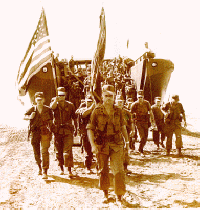
LTC
Robert B. Hankins leading
the 7/15th ashore at Qui Nhon
1 July 1967
A base camp for the 7th Bn, 15th Arty was established adjacent to the 41st Group Headquarters about two kilometers south of Phu Cat Airbase in the Central Highlands area. The first rounds fired against enemy targets by the Indianheads occurred on 16 July 1967. By then, A Btry had deployed to LZ English located just north of the Bong Son River to provide Heavy Artillery support to the 1st Air Cavalry (Cav) Division. Concurrently, B Btry and HHB deployed to LZ Uplift, on Highway One, south of the Bong Son River, also in support of the 1st Air Cav Division. Simultaneously, C Btry moved to Binh Khe (LZ Diamondhead) in support of the Republic of Korea (ROK) 1st Capital Division, while Service Btry remained at the Base Camp (later named Camp Fidel) near the Phu Cat Airbase.
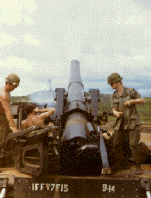
In October 1967, C Btry moved a two-gun Platoon to LZ Pony which was a Special Forces/Civilian Irregular Defense Group (CIDG) Camp located west of Highway One (QL-1) and south of the Bong Son River. By the end of October 1967, the two-gun platoon at LZ Pony was retubed as 175mm Guns, thereby extending their range to 32,800 meters. This provided the capability to reach out and touch the enemy in the western parts of the Central Highlands. The ability to retube quickly between 8-inch Howitzers and 175mm Guns was a craft that was practiced to perfection by the 7th Bn, 15th Arty throughout its entire four years and four months in the combat zone.
As 1968 opened, the 7th Bn, 15th Arty was heavily engaged in the Tet Offensive against targets of opportunity throughout Binh Dinh Province. As Tet was concluding at the end of February 1968, the last elements of the 1st Air Cav left the Central Highlands and completed their move north into the I Corps Area of Operation (AO) which was centered around Camp Evans. The 173rd Airborne (Abn) Brigade (Bde) was assigned the responsibility of the former 1st Air Cav Division AO and the 7th Bn, 15th Arty shifted their Heavy Artillery support to the 173rd Abn Bde. Throughout the remainder of 1968 and 1969, the 7th Bn, 15th Arty provided Heavy Artillery Support to the 173rd Abn Bde, the 4th Infantry Division (ID), the US Army Special Forces, and the Army of the Republic of Vietnam (ARVN) 22nd Infantry Division (ID).
By early 1970, the 7th Bn, 15th Arty moved its Headquarters further west from LZ Uplift to Camp Radcliff near An Khe. The 7/15th continued to support numerous operations in the vicinity of Pleiku, Kontum, Plei Trap, and farther west towards the Cambodian Border throughout the remainder of 1970. One of the more memorable Artillery Operations conducted during 1970 by the 7/15th occurred when a two-gun Platoon from A Btry conducted a week long Artillery raid at LZ Crusader, which brought them within 5 kilometers of the Cambodian Border. Many targets of opportunity were attacked by the Fighting Fifteenth in support of the ARVN 22nd ID, and netted a very large cache consisting of tons of weapons, ammunition, rice, and supplies. After a short move to Camp Fidel south of Phu Cat Airbase, the Battalion Headquarters was relocated to Artillery Hill outside of Pleiku by the end of 1970.
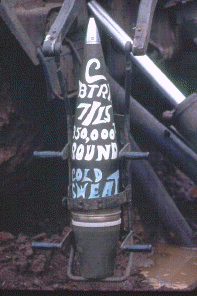
The 7/15th
fired round 350,000 in late 1971,
just prior to deactivation. The 175mm gun
"Cold Sweat" of C Battery was chosen
to fire the ceremonial round.
Photo credit: Tom Rethard
A major enemy offensive in the Ben Het area around Firebase 6 in March 1971, provided another opportunity for the Indianheads of the Fighting Fifteenth to deliver large volumes of accurate and deadly Heavy Artillery fire. From a location approximately 8 miles from the tri-border region of Vietnam, Laos, and Cambodia, the Fighting Fifteenth fired in continuous support of the ARVN 42nd Infantry Regiment during their combat operations against a determined foe. During this operation the Fighting Fifteenth rained steel hell onto a very large North Vietnamese Army (NVA) force that was attempting to destroy the ARVN 42nd Infantry Regiment and its supporting elements. After a bitterly contested battle, the enemy was driven from the area and chased back across the Cambodian and Laotian borders where he enjoyed a "safe sanctuary". Left behind was one of the largest enemy supply and ammunition caches known to exist inside South Vietnam.
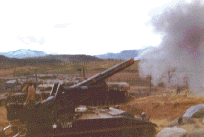
Photo: 15th
webmaster
Toward the end of 1971, the 7/15th began to turn over control of the Artillery Support Mission in the II Corps Military Region (MR2) to the ARVN forces. On 28 November 1971, the 7/15th ceased combat operations in the Republic of South Vietnam, The unit colors were returned by a Guard of Honor to Ft. Lewis, WA, and the 7/15th Artillery was subsequently deactivated. During the Battalion’s four years and four months in Vietnam, the Indianheads of the Fighting Fifteenth fired over 360,000 rounds of deadly and accurate Heavy Artillery fire, were credited with 850 enemy Killed By Artillery (KBA), destroyed over 1,200 reinforced bunkers, and destroyed numerous other hard targets.
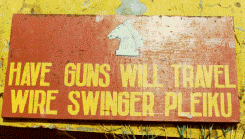
The Fighting Fifteenth was awarded a total of 13 streamers to add to its unit colors for the following campaigns:
Counteroffensive, Phase III
Tet Counteroffensive
Counteroffensive, Phase IV
Counteroffensive, Phase V
Counteroffensive, Phase VI
Tet 69/Counteroffensive
Summer-Fall 1969
Winter-Spring 1970
Sanctuary Counteroffensive
Counteroffensive, Phase VII
Consolidation I
Consolidation II
Cease Fire
Additionally, the Indianheads of the Fighting Fifteenth were awarded the Republic of Vietnam Cross of Gallantry w/Palm streamer embroidered VIETNAM 1967-1971.
![]()
Image: Institute of Heraldry
And as in three previous wars the Fighting Fifteenth paid their dues in blood as at least nineteen Indianheads gave their lives for their country, their flag, and their Regiment. Additionally, approximately two hundred Indianheads were Wounded In Action (WIA). The 7th Bn, 15th Field Artillery Association is continuing to conduct research to identify all additional KIAs not previously known. Also, the Association will continue to search for source materials to aid in documenting the History of the 15th Field Artillery Regiment, and will continue to locate former members of the Battalion.
As the Regiment's
motto clearly states. . .
ALLONS!
(French) Let's Go!
(English)
Written by: Dan Gillotti (15th Historian)
Other
7/15th webpages:
Reunions -
reunions of the 15th
15th Artillery in Vietnam -
two Vietnam battalions
USNS Walker - Navy ship that carried the 7/15th to Vietnam
7/15 Articles - interesting old news stories
7/15 Awards -
unit awards
7/15 History - history and
archive information
7/15th Photos - photos of Vietnam firebases and artillery
7/15 Wall - remembrance of men from the 7/15th
Big Guns - description of the heavy artillery pieces
Fire Mission - commands used in an artillery fire mission
Map Room - maps of the Central Highlands of Vietnam
"Do
not forget your dogs of war, your big guns,
which are the most-to-be respected
arguments of the rights of kings."
Frederick
the Great
